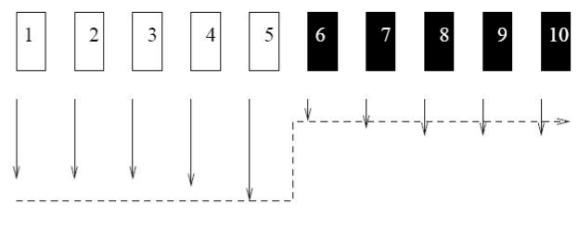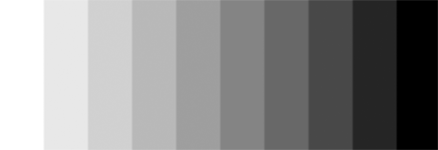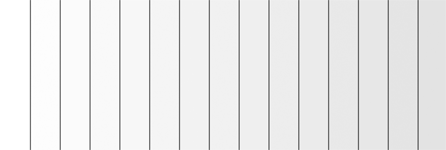Teaching:TUW - UE InfoVis WS 2008/09 - Gruppe 05 - Aufgabe 1 - Mach band
Mach Band[edit]
DEFINITION[edit]
OCCURENCE[edit]
The machband effect can be perceived by looking at two neighboring surfaces with different luminance that are either black and white or colored. The bigger the contrast in light intensities the more apperend Mach bands will be.
CAUSATION[edit]
The mach band effect is supposed to be caused by lateral inhibition. Imagine three neighbouring retina receptor cells - each one of them is stimulated at a different light-intensity level. The level of the stimulation is transformed into action potentials and later on forwarded to its neighbours. Inhibitory interneurons weaken these signals and transfer them to so called secondary neurons. The attenuation is proportional to the excitation of the interneurons. By the summation of exciting and alleviative factors to the second neuron a contrast enhancement is archieved.
As shown in the image below, we have to examine the edge which is represented schematically between an homogenous bright area (between receptor 1 and 5) and an homogenous dark area (between receptor 6 and 10). Without interaction every receptor of 1 to 5 would represent the same high and every receptor from 6-10 the same low signal. But because of the connection by an horizontal receptor cell the signal of for example receptor 3 is attenuated because his neighbours impact on it inhibitorily. Only 5 and 6 are not affected because the have the same amount of inhibitory and excitatory neighbours.
EXAMPLES[edit]
White to black in 10 Steps
White to grey (255,255,255 -> 200,200,200) in 20 Steps
White to a lighter grey(220) in 20 steps - The difference should be visible
Same as above but with seperators - The usual human eye probably can not differ the different tones in the middle of this example
The four images Shown in the "Examples" Section have been made by the Mach Banding Interactive Demonstration.
Machband and Rendering[edit]
Due to the linear intensity interpolation the Mach bands can cause distortion when rendering with Gouraud Shading. In this particular area, the machband can appear on the edges of polygons and cause an unintentional visual effect. A rendering method which can work around the problems caused by the mach-bands is Phong Shading.
LINKS[edit]
[Mach Banding Interactive Demonstration] http://www.nbb.cornell.edu/neurobio/land/OldStudentProjects/cs490-96to97/anson/MachBandingApplet/
REFERENCES[edit]
[Schmitt, Sturm, Pries, 2006] Lutz Pries, Frank Schmitt, Patrick Sturm. Fragmente eines Skripts zur Bildverarbeitung. 31. Oktober 2006, http://www.uni-koblenz.de/~lb/lehre/ws2006/bv/bvbuch.pdf
[Jo Baer, 2008] Jo Bear, Mach bands. Retrieved at 22.11.2008. http://www.ubu.com/aspen/aspen8/machBands.html
[Biokurs.de] Lichtsinn. http://www.biokurs.de/skripten/12/bs12-38b.htm
[Wikipedia, 2008] Wikipedia.org, Laterale Hemmung. Retrieved at 22.11.2008. http://de.wikipedia.org/wiki/Laterale_Hemmung
[Wikipedia, 2008] Wikipedia.org, Mach bands. Retrieved at 22.11.2008 http://en.wikipedia.org/wiki/Mach_bands
[Perceptual Stuff] http://perceptualstuff.org/machbandsbasic.html
[The Joy of Visual Perception] http://www.yorku.ca/eye/machband.htm
[Mach Banding Interactive Demonstration] http://www.nbb.cornell.edu/neurobio/land/OldStudentProjects/cs490-96to97/anson/MachBandingApplet/




